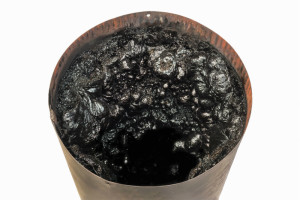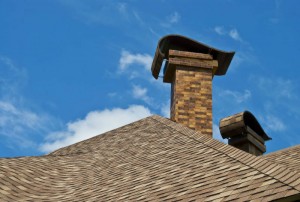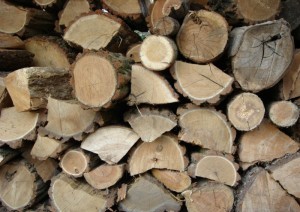by Billy Sweet | Feb 19, 2019 | Creosote
Many homeowners across the U.S. have been using their fireplaces for several weeks. In that time, the fires have produced soot consistently, and wood fires produce creosote as well. Every fire that burns wood will produce creosote because it is a natural byproduct, but how much creosote is produced will depend on the type of wood you burn.
The Problem with Creosote
Creosote can be no problem as long as it’s cleaned on a regular basis. When cleaned regularly, creosote can be removed safely by a professional using brushes and a vacuuming system during a routine chimney sweep. When these important services are neglected, the sticky creosote can buildup and lead to an obstruction that slows down the air in the chimney system. When homeowners continue to use a dirty system, the airflow slows significantly and the high temperatures cause the creosote to boil and the water in it to evaporate. Once the water evaporates, what is left is a dense, hard mass of concentrated tar–a highly flammable material left right in the line of fire.
Glazed Creosote
A level three creosote buildup is called “glazed creosote” because the creosote takes on a hardened, shiny look after repeated heating and cooling. As the creosote problem worsens, the airflow slows and heated air lingers in the flue, raising the risk of flue fire. When glazed creosote ignites, it results in an intense, fast burning fire that expends a large amount of gas and energy. This burst of energy can crack the flue liner, damage the masonry, and spread to other parts of the house. Other times a flue fire can occur and a homeowner won’t even notice. It’s important to schedule a chimney inspection if you suspect a flue fire. The first flue fire may damage the system, and a second flue fire can travel through damaged masonry to the rest of the house.
Glazed Creosote Removal
Soot and creosote is easily removed during a routine chimney sweep. Glazed creosote, however, cannot be removed using the same methods. Some amateurs may attempt to remove the creosote by prying it away, but this never removes it completely and even leaves scratches and other damage to the liner. Hire a professional who knows the safe and proper methods for glazed creosote removal. At Billy Sweet Chimney Sweep we use industrial products to safely remove glazed creosote without leaving any damage to the system. This trusted product can be sprayed or wiped onto the glazed creosote. As it’s absorbed, the creosote flakes away and can be swept away and collected just like soot.
Prevent Creosote Buildup
You can prevent a dangerous and dirty chimney system by scheduling professional services annually and using your system properly.
-Schedule routine chimney sweeps to clean the flue of soot and creosote before a buildup occurs.
-Burn only properly seasoned wood. Green or fresh wood produces more creosote while burning.
-Schedule chimney inspections annually so you can rest assured your system is working properly and the wood is burning completely.
-Pay attention to signs such as flakes in the fireplace or slick, black material on the masonry.
Schedule services with the licensed professionals at Billy Sweet Chimney Sweep today. Call 617-469-4528 or schedule online.
by Billy Sweet | Aug 30, 2018 | Creosote, Uncategorized
To say creosote is a minor problem would be an understatement. Creosote is neither rare nor harmless. Every wood-burning fire that you burn in your fireplace and chimney system produces smoke that rises up the chimney. The smoke is filled with hot gases, particles, soot, and creosote that covers the chimney interior. Though soot can be corrosive to the chimney liner and masonry, creosote presents a whole different set of problems.
Creosote Buildup
Soot is made up of carbon, but creosote is made up mostly of tar–a sticky substance that is also flammable. Because of the sticky nature of creosote, it collects easily in a chimney, covering parts, clogging the clean out area, and creating a fire hazard. As the creosote builds up, it can become a serious obstruction–and when it reaches stage 3 buildup it is also difficult to remove.
Stage 3 Creosote
Stage 3 creosote, also called glazed creosote becomes a problem only when the chimney isn’t cleaned regularly. When the creosote isn’t removed on a regular basis, it builds up. When it becomes heated, the creosote boils, causing all the moisture in it to evaporate, and leaves a hardened mass of condensed fuel in the flue. Once it reaches this stage, the creosote can’t be brushed away during a standard chimney sweep. It decreases the chimney’s efficiency, increases the amount of creosote produced by the inefficient fire, and raises the risk of flue fire.
Chimney Damage
Creosote will not damage the chimney when it is cleaned regularly and properly. Once creosote reaches stage 3 buildup it can be difficult to remove without damaging the liner. You cannot remove it with brushes and a homeowner or handyman attempting to do so with tools will cause damage. Additionally, if it isn’t removed, the glazed creosote can cause a creosote fire that damages the masonry, the liner, and even the structure of the chimney. If you suspect a flue fire, you should call a chimney professional for an assessment right away.
Prevent Creosote Buildup
You cannot stop creosote altogether, but you can prevent dangerous buildups.
Schedule Regular Chimney Sweeps – Your chimney sweep appointments will keep your chimney working properly and the chimney professional will assess it with each appointment.
Burn Properly Seasoned Wood – Burning wet or “green” wood that is freshly cut will drop the efficiency of your fireplace. Green wood is harder to light and burns with less heat, often burning incompletely. This leads to more creosote. Burn only properly seasoned firewood in your fireplace to keep your chimney system working properly.
When you do have a creosote buildup in your chimney, it’s important to call the professionals for proper and safe removal. Billy Sweet Chimney Sweep technicians use an industrial product to remove the creosote without damaging the liner and then we clean the entire flue.
Give us a call before you try to remove creosote yourself. It’s harmful to breathe, may irritate your skin, and can destroy your flue if it results in a fire.
Talk to a professional today at 617-469-4528.
by Billy Sweet | Dec 26, 2015 | Creosote
If you have a fireplace, you likely know that creosote can be a hazard to your home and family. You probably also have your fireplace swept by a certified chimney sweep each year to remove any creosote buildup from your chimney, and perhaps you even burn the occasional creosote sweeping log to help maintain your chimney. But how much do you know about creosote, how it forms, the dangers it poses and how you can keep it at bay? We’ve put together some basic information on creosote so you can better protect your home and family.

What is creosote?
As smoke from your fireplace makes its way to the top of your chimney, it cools. As the smoke cools, it causes condensation of the chemicals and water vapor created when wood burns. The substance left sticking to your walls is creosote. All forms of creosote — whether black or brown, sticky or shiny, hard or tar like — can be found sticking to the insides of most chimneys.
Why is creosote dangerous?
As little as a quarter inch of creosote buildup on the walls of your chimney can be dangerous, putting your home at risk of a chimney fire. Highly combustible, creosote can burst into flames if it is touched by a stray spark from your fireplace, or if chimney temperatures exceed 1,000 degrees. If creosote builds up enough in your chimney, it also can prevent the gases created by the fireplace from exiting your home, which can force dangerous carbon monoxide back into your home.
How can I avoid the dangers of creosote?
Using the right wood in your fireplace can slow the buildup of creosote in your chimney. Only burn dry hardwoods that have been seasoned for a minimum of six months. When wood is improperly seasoned and contains moisture, it produces more water vapor when burned and burns at a cooler temperature, which causes the formation of creosote. Make sure that your fire is large enough for your fireplace. If your logs are too small, the fire won’t burn hot enough for your chimney. Your flue also should be fully opened when you’re burning a fire, as a partially closed flue will cause smoke to remain in your flue longer, encouraging creosote buildup.
Of course, the best way to keep your home safe from a creosote fire is to have your chimney swept and inspected each year by a certified chimney sweep. Your chimney sweep will make sure that your chimney is entirely creosote free. During the sweep’s inspection, he also will make sure your chimney does not show any signs of damage from a past creosote fire, which can weaken your chimney and put your home at danger for a future fire.
If you’re overdue for a chimney sweeping and inspection, don’t wait! Putting off your chimney sweeping puts your home and family in danger of a creosote-caused chimney fire or carbon monoxide poisoning. Call the certified sweeps at Billy Sweet to have your chimney ready for the fire-burning season.
by Billy Sweet | Jun 30, 2015 | Summer Chimney Sweeping
Summertime is here, and homeowners are switching on the A/C, spending time outdoors and searching for ways to fight the heat. It’s no surprise that the state of your fireplace is probably the last thing on your mind; after all, you won’t be utilizing it again for at least a few months.
Once September rolls around, however, the temperatures can drop sharply, leading homeowners to consider utilizing their fireplaces for warmth and relaxation.
Unfortunately, many homeowners are unaware of the importance of having their chimney swept before starting that first autumn fire.
Check out these important reasons to get your chimney swept before the fall.

Avoid the Rush
Once fall arrives, chimney sweeps are very busy; their schedules are typically backed up for days or even weeks at a time. Waiting until fall to schedule your sweeping could mean a long delay or having to shop around for another company that can accommodate you.
You can avoid the rush by getting your chimney swept before fall arrives. You won’t have to wait for an opening, and you can head into the colder season knowing your fireplace is ready for use.
Prevent Chimney Fires
Your chimney functions as the avenue through which dangerous flue gases and other fireplace by-products can pass safely out of your home.
These by-products include water vapor, hydrocarbon, wood particles, smoke, and tar fog, among others. As these by-products flow up through your chimney and mingle with the cooler temperatures at the top, condensation occurs, resulting in a tar-like coating on the walls of your chimney known as creosote.
Creosote is highly combustible, and building a fire in your fireplace when it has an excess buildup of creosote on its walls puts you at serious risk for a chimney fire. Getting your chimney swept regularly, and especially after a long summer of not using your fireplace, is the easiest way to get rid of creosote and prevent a chimney fire.
Prevent Unpleasant Odors
One of the main reasons homeowners invest in a fireplace is to add ambiance and luxury to their home; unfortunately, for homeowners who fail to keep their chimney clean, an unpleasant odor may begin seeping from their fireplaces into their homes during the summer months.
The heat and humidity of summer weather can cause reactions in the creosote and by-products of a dirty chimney, causing the emission of a sour, burnt odor that no homeowner wants to experience.
Getting your chimney cleaned during the summer can help minimize the presence of these bad odors and keep your home clean and comfortable.
Prevent Life-Threatening Gases from Accumulating in Your Home
A blocked or malfunctioning chimney is one of the leading causes of the accumulation of carbon monoxide in homes; in fact, carbon monoxide poisoning is responsible for 200 deaths in the United States each year.
It is essential that you get your chimney swept on a regular basis, to ensure that your flue is venting and functioning properly. A regular sweeping will also prevent the accumulation of creosote, acidic water vapors and soot that can cause chimney blockages and thus the dangerous accumulation of noxious, life-threatening gases in your home.
Extend the Life of Your Fireplace
The accumulation of fire by-products in your chimney can cause damage to the structure of your chimney, your home and your fireplace. You’ve made an expensive investment and deserve to enjoy its benefits for years to come.
by Billy Sweet | Dec 19, 2014 | Seasoned Firewood
Staying warm this winter requires the proper preparation. For maintaining a comfortable temperature inside the home, this could involve starting a fire in the wood burning stove or fireplace. To ensure the hottest, most fuel efficient fire, you have to start off with the best firewood.

The most critical trait to consider in your firewood is the extent of its seasoning. To be seasoned is to have been allowed to dry fully by being stored indoors for a specific amount of time. Essentially, seasoned wood means dry wood. How long the wood needs to completely season varies based on the type of wood. Softer varieties of wood may season in six month, while hardwoods can require as long as two years to achieve completer dryness.
Preferably, any wood you burn should have been allowed to season completely prior to burning. To follow this guideline, you have two options. First, you can purchase wood that is already fully seasoned. This wood can be burned right away for the best fuel efficiency, but you may have a hard time finding it. If you do find well seasoned wood for sale, it probably costs significantly more than the wet wood. The other option is to purchase wet wood and allow it to season in a shed or garage. This option saves you upfront costs, but it involves planning one or two years in advance. Either option you choose, you should always burn seasoned wood. A lot of energy is wasted on wet wood by boiling away the trapped moisture, so you end up with a colder fire, excess smoke, more spent on fuel, and incompletely burnt wood.
Incompletely burnt wood creates health risks because it produces a black, tarry material called creosote. Initially a vapor as it exits the fire, creosote condenses inside the chimney. Over time the creosote can build up and restrict the air flow through the chimney, which can lead to poor indoor air quality. The high flammability of creosote can also result in a chimney fire from a mere stray ember. Luckily, avoiding this risk is as easy as burning seasoned wood and having an annual chimney sweep and inspection done.
Just because you purchase seasoned wood does not mean it stays seasoned forever. How you store the wood after you buy it and before you burn it determines whether or not it remains fully seasoned. The ideal storage arrangement involves stacking the wood, with a depth of only one log, in a shed or other outdoor building. Leave the wood uncovered to prevent condensation. If the wood must sit outside, protect it from the elements by creating a sturdy roof for it. A piece of sheet metal works well. Be sure to leave the sides of the stack uncovered to encourage air flow.
If you have any questions about firewood or if you need to schedule a chimney sweep or inspection, contact Billy Sweet Chimney Sweep to speak with an expert.





